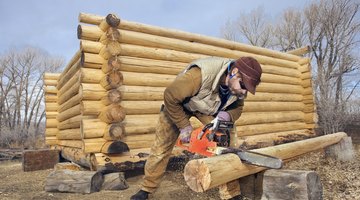Types of Wood Used in Log Cabins
Table of Contents
Modern log cabins are usually constructed from softwoods such as cedars and spruces. Softwoods have excellent thermal qualities, are relatively inexpensive, and provide an attractive appearance. Wood from other tree species are also used in log cabins, each with specific benefits and weaknesses.

When choosing a wood for use in a log cabin, factor in appearance (the color and grain), stability (risk of warping), practicality and the wood's reaction to insects and temperature shifts.
White Pine Logs
White pine is often used for log cabin construction in Eastern regions of the United States. White pine ranges from a white to yellowish brown color and is relatively lightweight. It has a uniform grain, is relatively low cost, and is resistant to the dangers of warping and shrinking. White pine also provides good thermal qualities, is very strong, and is fairly resistant to deterioration. As it ages, white pine gradually shifts to a dark orange color.
Red Cedar Logs
Red cedar is a soft, aromatic wood that is relatively low in strength. It has a straight grain, is practical for cabin construction and shows resistance to decay in bad weather conditions. Red cedar is naturally resistant to insects and is non-resinous, which makes it ideal for wet climates. Red cedar has good insulation qualities, which can lead to reduced heating and cooling expenses, but it's an expensive material compared to other types of wood.
Yellow Pine Logs
Yellow pine is a hard wood that is easy to use for cabin-building. It is pale yellow in appearance with a grain mold of dark and light. Yellow pine is harder than white pine and contains a high resin level. It is also very resistant to decay compared to other pines, but not as resilient as cedar. Yellow pine is quite inexpensive and is an excellent choice for constructing log floors, door framing and furniture. For structural log cabin walls, however, white pine is a better option.
Oak Logs
Although oak can be an excellent choice for log cabin construction, it is not commonly employed because the logs can be very expensive. Oak is heavy, strong and highly resistant to wet weather and age-related decay. It is available in a range of colors, from pale whitish-brown to deep, grainy reds. Unfortunately, it is also difficult to work with, which means you should employ builders experienced at constructing oak log cabins to complete the job.
Spruce Logs
Spruce is mainly used in Northern areas of the United States and Canada. It is a light, resinous softwood with a straight grain that dries out swiftly and retains stability. Spruce is rather strong and moderately easy to work with for log cabin construction. It is also inexpensive and stable in dry climates, but it’s not naturally resistant to the effects of decay.
The Drip Cap
- Modern log cabins are usually constructed from softwoods such as cedars and spruces.
- As it ages, white pine gradually shifts to a dark orange color.
- Red cedar has good insulation qualities, which can lead to reduced heating and cooling expenses, but it's an expensive material compared to other types of wood.
- Yellow pine is a hard wood that is easy to use for cabin-building.
- Oak is heavy, strong and highly resistant to wet weather and age-related decay.
- It is a light, resinous softwood with a straight grain that dries out swiftly and retains stability.
References
Writer Bio
Jason Prader began writing professionally in 2009, and is a freelance writer with a sound academic background and experience in writing articles for online magazine Shavemagazine.com. He is highly adept at constructing academic essays and producing articles on an array of subject matter. He holds a master's degree in 20th century literature from the University of Sussex.
Photo Credits
- Thinkstock/Stockbyte/Getty Images
- Thinkstock/Stockbyte/Getty Images
More Articles



